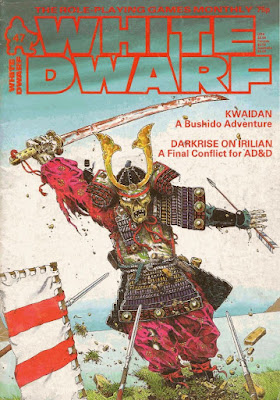"The Demonist" by Phil Masters is a new character class for use with AD&D, following in the footsteps of the demon summoning rules for RuneQuest presented in the previous three issues. The class is basically a variant (evil only) cleric, with a unique spell list, including some original spells, like soul shield and summon imps. New character classes – or "NPC classes," if it's published in the pages of Dragon – have been a staple of the hobby since 1974. Most of them aren't especially interesting, so Masters deserves some credit for creating one that's not dull. That said, I'm not sure there's much need for the demonist as a distinct class, when simply creating new spells for evil clerics would suffice.
"Open Box" reviews four products this month, starting with FGU's Privateers and Gentlemen, which earns 9 out of 10 – much higher than I would have expected. The Asylum and Other Tales also receives 9 out of 10, while Starfleet Battles Supplement #1 is rated 7 out of 10. Big Rubble, on the other hand, gets a fairly nuanced rating: 10 at best, much 8–9, some scenarios 5–6. Nuanced ratings is nothing new to White Dwarf. Many ratings are divided between presentation, rules, playability, and complexity, with a single overall rating for the entire package. This is the first time, though, that I can recall seeing the "overall" rating (which is what I usually report in my posts) broken up in this way.
Dave Langford's "Critical Mass" reviews Asimov on Science Fiction, a nonfiction book in which Isaac Asimov offers his thoughts and opinions about the genre and its practitioners. Langford's opinion of the book is mixed. Much of it is clear, lucid, and sensible. However, Asimov's own prejudices and his incessant self-promotion mar what might have otherwise been a solid tome. Fond though I am of much of Asimov's oeuvre, I find it difficult to disagree with Langford's assessment. "Zine Scene" by Mike Lewis is the inaugural column devoted to gaming fanzines. Lewis introduces himself to the reader, along with a handful of 'zines he thinks worthy of mention.
"Extracts from the Travels of Tralk True-Eye" by Ian Bailey presents details and game stats for several types of goblins for use with RuneQuest. The goblins are imaginative and varied, which is nice, though I'm not sure how well they'd fit into Glorantha. Mind you, I often forget that White Dwarf regularly published "generic" RQ articles that were not tied to Glorantha and this appears to be another of them. I suppose it's a testament of how ingrained Glorantha is to my own conception of RuneQuest that I even think to ponder questions like this. "Aliens" by Phil Masters presents two new non-human species for use with Traveller: the crustacean-like Phulgk'k'k'k and the small ape-like Ghashruan.
The conclusion to Daniel Collerton's "Irilian" gives readers a two-page color map of the entire city. Irilian's main buildings are keyed but, to make full use of it, one must possess the previous five issues of White Dwarf. Accompanying the map is the final part of the six-part adventure, "The Rising of the Dark," which takes place within the city's walls, along with random encounter tables and information on civil and religious law. It's a terrific end to a terrific series of articles. "Irilian" was what finally convinced me to subscribe to White Dwarf after picking up single copies of it for years. That likely explains the fondness I have for the whole series and the city it depicts.
"Rune Rites" presents two very short articles for use with RuneQuest. The first, "Daily Health" by Paddy Barrow is a very odd one. It's a set of random tables to determine "how a player character feels on a certain day." Sub-tables are used if a character feels particularly good or bad, with game mechanical effects coming into play. Perhaps this might be useful on occasion, but it strikes me as a perfect example of the randomness fetishism that frequently afflicts long-time gamers. Much better is Dave Morris's "Force of Will," which codifies a system for measuring a character's ability to resist debilitating/demoralizing effects. The system is simple and easy to use; it makes a for a consistent alternative to the haphazard way RQ used to handle this sort of thing.
"Kwaidan" by Oliver Johnson and Dave Morris is a nifty little adventure scenario for Bushido. As its title suggests, it presents a ghost story set in feudal Japan. It's quite well done, with detailed NPCs, maps of a village, a monastery, and a manor house, and of course the ghosts wreaking havoc in the region. I haven't had the chance to play Bushido in years; reading "Kwaidan" makes me wish I were. "Treasure Chest" presents a mini-scenario based around a couple of weird magic items, including the "Dorianic Portrait," while "Mini-Monsters" offers five small monsters for use with D&D. The issue concludes with the latest installments of "Thrud the Barbarian" and "The Travellers," the former of which is especially amusing.
As I alluded to earlier, this issue comes from the period when I was reading White Dwarf religiously, as a companion and counterpoint to Dragon, to which I was also subscribing. Consequently, I have a lot of affection for these issues. At the same time, it's obvious in retrospect that White Dwarf was changing – becoming slicker, more professional, and diversifying its content. In addition, Game Workshop was itself changing and those changes would soon enough impact White Dwarf itself. This knowledge doesn't adversely affect my delight in re-reading issues like this one, but it does remind that Golden Ages rarely last long, no matter how great their glory.


No comments:
Post a Comment